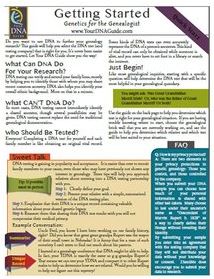 Why test your DNA for genealogy without even having a specific research question in mind? Here are 3 reasons.
Why test your DNA for genealogy without even having a specific research question in mind? Here are 3 reasons.
My youngest child, Eleanor, is nearly 8, so it was fun to have a 2 year old over the other day. She loved following Eleanor around, and Eleanor was equally thrilled to have someone to mentor in the ways of big girl play. I took special delight in listening to my daughter’s patient and surprisingly complete answers to our guest’s constant inquiries of “Why?” It got me thinking about the whys of genealogy, and especially of genetic genealogy.
I decided that there are three main reasons to test your DNA for genealogy:
1. DNA is primary information.
In genealogy, primary information is given by a source with firsthand knowledge of an event, with the best primary information being created at or around the time of the event. I think we can safely say that DNA falls into that category on both counts. Therefore, it is an excellent source of genealogical information and should be obtained as part of a thorough genealogical search.
2. DNA is a unique record.
DNA possesses several qualities that make this record type stand out from the rest. First and foremost, it cannot be falsified in any way. No name change, no deception, no miscommunication or misspelling can tarnish this record. Even if it is not a complete record of our family history, the story that it does tell is accurate.
3. DNA is a physical link to our past.
So much of genealogy work, especially in today’s digital world, is intangible. We add ancestors to our pedigree charts with a click of our mouse, having no idea of their physical characteristics, never once setting foot in the same places that they did, or if they preferred bread and butter or toast and jam.
But with the advent of DNA testing, I am able to see a physical connection between me and my ancestor. The first time I saw it seems unremarkable. It was just a blue line on top of a grey line, representing the location in the DNA where I had the same information as my cousin. But that line meant that we had both inherited a physical piece of DNA from our common ancestor, Lucy J. Claunch.
That realization didn’t add names or dates to my pedigree chart- Lucy had been on my chart since the beginning. But it did add a sense of purpose and reality to my genealogical work. In short, it inspired me to know more about Lucy and to tell her story because I felt inextricably tied to it. Perhaps many of you don’t need a DNA test to feel similarly motivated. Perhaps you already understand what I learned: her story is my story. But because I have her DNA in me, I am able to take that idea one step further. Because she lives on in me, my story is her story. So I better make it a good one.
 I can help you get started in DNA for genealogy with my Getting Started: Genetics for the Genealogist quick reference guide. This guide:
I can help you get started in DNA for genealogy with my Getting Started: Genetics for the Genealogist quick reference guide. This guide:
- helps you select the DNA test (and testing company) that’s right for you
- explains what DNA can and can’t do for your research;
- identifies who in your family should be tested;
- explains privacy measures; and
- tells you how to take a test.
If you’re ready to take on DNA, consider my entire value-priced bundle of DNA guides–for all the different types of testing and testing companies you may be considering. And you can always come to me for further consultation at my website.
